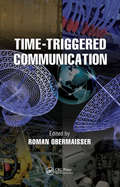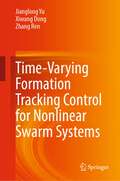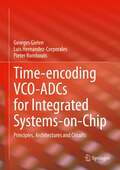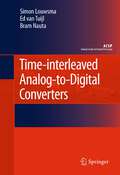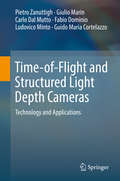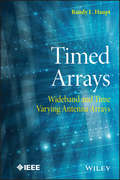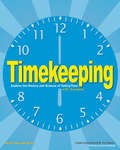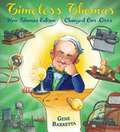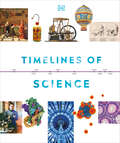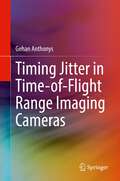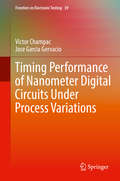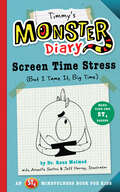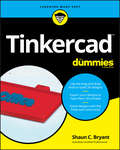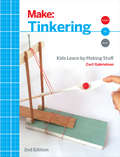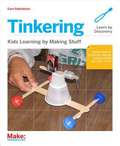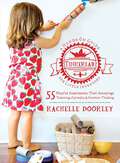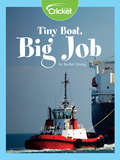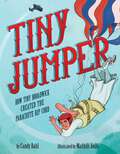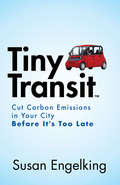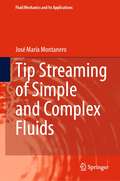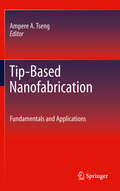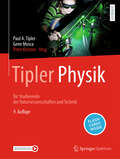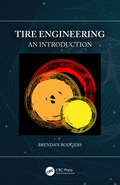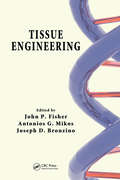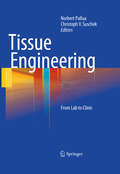- Table View
- List View
Time-Triggered Communication (Embedded Systems)
by Roman ObermaisserTime-Triggered Communication helps readers build an understanding of the conceptual foundation, operation, and application of time-triggered communication, which is widely used for embedded systems in a diverse range of industries. This book assembles contributions from experts that examine the differences and commonalities of the most significant protocols including: TTP, FlexRay, TTEthernet, SAFEbus, TTCAN, and LIN. Covering the spectrum, from low-cost time-triggered fieldbus networks to ultra-reliable time-triggered networks used for safety-critical applications, the authors illustrate the inherent benefits of time-triggered communication in terms of predictability, complexity management, fault-tolerance, and analytical dependability modeling, which are key aspects of safety-critical systems. Examples covered include FlexRay in cars, TTP in railway and avionic systems, and TTEthernet in aerospace applications. Illustrating key concepts based on real-world industrial applications, this book: Details the underlying concepts and principles of time-triggered communication Explores the properties of a time-triggered communication system, contrasting its strengths and weaknesses Focuses on the core algorithms applied in many systems, including those used for clock synchronization, startup, membership, and fault isolation Describes the protocols that incorporate presented algorithms Covers tooling requirements and solutions for system integration, including scheduling The information in this book is extremely useful to industry leaders who design and manufacture products with distributed embedded systems based on time-triggered communication. It also benefits suppliers of embedded components or development tools used in this area. As an educational tool, this material can be used to teach students and working professionals in areas including embedded systems, computer networks, system architectures, dependability, real-time systems, and automotive, avionics, and industrial control systems.
Time-Varying Formation Tracking Control for Nonlinear Swarm Systems
by Xiwang Dong Zhang Ren Jianglong YuThe book focuses on time-varying formation control approaches for practical nonlinear swarm systems. Time-varying formation control is the basic guarantee for performing other tasks of swarm systems, such as cooperative decision-making and cooperative detection. However, most practical swarm systems have nonlinear dynamic models. This book studies three typical models of practical nonlinear swarm systems, which represent most of the practical systems and construct the corresponding formation control structure. At the same time, the effects of disturbances, uncertain dynamics, random noise and unknown leader's input are considered and processed to improve the robustness and adaptability. The comprehensive and systematic treatment of practical nonlinear time-varying formation control issues is one of the major features of the book, which is particularly suited for readers who are interested to learn time-varying formation control solutions in nonlinear swarm systems. The book benefits researchers, engineers and graduate students in the fields of formation control, nonlinear control, robust control, etc.
Time-encoding VCO-ADCs for Integrated Systems-on-Chip: Principles, Architectures and Circuits
by Georges Gielen Luis Hernandez-Corporales Pieter RomboutsThis book demonstrates why highly-digital CMOS time-encoding analog-to-digital converters incorporating voltage-controlled oscillators (VCOs) and time-to-digital converters (TDCs) are a good alternative to traditional switched-capacitor S-D modulators for power-efficient sensor, biomedical and communications applications. The authors describe the theoretical foundations and design methodology of such time-based ADCs from the basics to the latest developments. While most analog designers might notice some resemblance to PLL design, the book clearly highlights the differences to standard PLL circuit design and illustrates the design methodology with practical circuit design examples.Describes in detail the design methodology for CMOS time-encoding analog-to-digital converters that can be integrated along with digital logic in a nanometer System on Chip;Assists analog designers with the necessary change in design paradigm, highlighting differences between designing time-based ADCs and traditional analog circuits like switched-capacitor converters and PLLs;Uses a highly-visual, tutorial approach to the topic, including many practical examples of techniques introduced.
Time-interleaved Analog-to-Digital Converters
by Simon Louwsma Ed Van Tuijl Bram NautaTime-interleaved Analog-to-Digital Converters describes the research performed on low-power time-interleaved ADCs. A detailed theoretical analysis is made of the time-interleaved Track & Hold, since it must be capable of handling signals in the GHz range with little distortion, and minimal power consumption. Timing calibration is not attractive, therefore design techniques are presented which do not require timing calibration. The design of power efficient sub-ADCs is addressed with a theoretical analysis of a successive approximation converter and a pipeline converter. It turns out that the first can consume about 10 times less power than the latter, and this conclusion is supported by literature. Time-interleaved Analog-to-Digital Converters describes the design of a high performance time-interleaved ADC, with much attention for practical design aspects, aiming at both industry and research. Measurements show best-inclass performance with a sample-rate of 1.8 GS/s, 7.9 ENOBs and a power efficiency of 1 pJ/conversion-step.
Time-of-Flight and Structured Light Depth Cameras
by Pietro Zanuttigh Giulio Marin Carlo Dal Mutto Fabio Dominio Ludovico Minto Guido Maria CortelazzoThis book provides a comprehensive overview of the key technologies and applications related to new cameras that have brought 3D data acquisition to the mass market. It covers both the theoretical principles behind the acquisition devices and the practical implementation aspects of the computer vision algorithms needed for the various applications. Real data examples are used in order to show the performances of the various algorithms. The performance and limitations of the depth camera technology are explored, along with an extensive review of the most effective methods for addressing challenges in common applications. Applications covered in specific detail include scene segmentation, 3D scene reconstruction, human pose estimation and tracking and gesture recognition. This book offers students, practitioners and researchers the tools necessary to explore the potential uses of depth data in light of the expanding number of devices available for sale. It explores the impact of these devices on the rapidly growing field of depth-based computer vision.
Timed Arrays
by Randy L. HauptIntroduces timed arrays and design approaches to meet the new high performance standards The author concentrates on any aspect of an antenna array that must be viewed from a time perspective. The first chapters briefly introduce antenna arrays and explain the difference between phased and timed arrays. Since timed arrays are designed for realistic time-varying signals and scenarios, the book also reviews wideband signals, baseband and passband RF signals, polarization and signal bandwidth. Other topics covered include time domain, mutual coupling, wideband elements, and dispersion. The author also presents a number of analog and digital beamforming networks for creating and manipulating beams. The book concludes with an overview of the methods to integrate time delay into the array design and of several other adaptive arrays that prove useful in many different systems. Examines RF signal concepts such as polarization and signal bandwidth and their applications to timed antenna arrays Covers arrays of point source, elements in timed antenna arrays, active electronically scanned array technology, and time delay in corporate fed arrays Includes complete design examples for placing time delay in arrays Timed Arrays: Wideband and Time Varying Antenna Arrays is written for practicing engineers and scientists in wireless communication, radar, and remote sensing as well as graduate students and professors interested in advanced antenna topics.
Timekeeping
by Sam Carbaugh W Eric Martin Linda FormichelliTimekeeping: Explore the History and Science of Telling Time travels through the past and into the future to explore how humans have measured the passage of time. From ancient civilization's earliest calendars and shadow clocks to GPS and the atomic clocks of today, kids will track the evolution of timekeeping devices, meet the inventors of calendars and clocks, and learn interesting facts and trivia. Hands-on projects and activities include making a shadow clock, using a protractor to create a sundial, measuring time using water, and creating your own calendar. Kids will understand how civilization's vague abilities to track days and months has transformed over the centuries into a sophisticated ability to keep time to the millionth of a second.
Timeless Thomas: How Thomas Edison Changed Our Lives
by Gene BarrettaWhat do record players, batteries, and movie cameras have in common? All these devices were created by the man known as The Wizard of Menlo Park: Thomas Edison. Edison is most famous for inventing the incandescent lightbulb, but at his landmark laboratories in Menlo Park & West Orange, New Jersey, he also developed many other staples of modern technology. Despite many failures, Edison persevered. And good for that, because it would be very difficult to go through a day without using one of his life-changing inventions. In this enlightening book, Gene Barretta enters the laboratories of one of America's most important inventors.
Timelines of Science (DK Timelines)
by DKFrom the wheel to the worldwide web, our planet has been transformed by science.Now you can travel through time to experience centuries of invention and innovation on this spectacular visual voyage of discovery. Starting in ancient times and ending up in the modern world, you&’ll explore scientific history showcased in stunning images and captivating text. An easy-to-follow illustrated timeline runs throughout the book, keeping you informed of big breakthroughs and key developments. Get to grips with revolutionary ideas like measuring time or check out amazing artifacts like flying machines. Great geniuses, including Marie Curie, Albert Einstein, and Charles Darwin are introduced alongside their most important ideas and inventions, all shown in glorious detail. Hundreds of pages of history are covered in Timelines of Science, with global coverage of scientific advances. Whether you're joining in with eureka moments, inspecting engines, or learning about evolution, all aspects of science are covered from the past, present, and future.
Timing Jitter in Time-of-Flight Range Imaging Cameras
by Gehan AnthonysThis book explains how depth measurements from the Time-of-Flight (ToF) range imaging cameras are influenced by the electronic timing-jitter. The author presents jitter extraction and measurement techniques for any type of ToF range imaging cameras. The author mainly focuses on ToF cameras that are based on the amplitude modulated continuous wave (AMCW) lidar techniques that measure the phase difference between the emitted and reflected light signals. The book discusses timing-jitter in the emitted light signal, which is sensible since the light signal of the camera is relatively straightforward to access. The specific types of jitter that present on the light source signal are investigated throughout the book. The book is structured across three main sections: a brief literature review, jitter measurement, and jitter influence in AMCW ToF range imaging.
Timing Performance of Nanometer Digital Circuits Under Process Variations (Frontiers In Electronic Testing Ser. #39)
by Victor Champac Jose Garcia GervacioThis book discusses the digital design of integrated circuits under process variations, with a focus on design-time solutions. The authors describe a step-by-step methodology, going from logic gates to logic paths to the circuit level. Topics are presented in comprehensively, without overwhelming use of analytical formulations. Emphasis is placed on providing digital designers with understanding of the sources of process variations, their impact on circuit performance and tools for improving their designs to comply with product specifications. Various circuit-level “design hints” are highlighted, so that readers can use then to improve their designs. A special treatment is devoted to unique design issues and the impact of process variations on the performance of FinFET based circuits. This book enables readers to make optimal decisions at design time, toward more efficient circuits, with better yield and higher reliability.
Timmy's Monster Diary: Screen Time Stress (But I Tame It, Big Time) (Monster Diaries #2)
by Raun Melmed Annette SextonMeet Timmy, a lovable monster who can’t get enough of the coolest gadgets and video games. Too bad he doesn’t realize how much time he spends each day in front of a screen. In the same humorous spirit of Diary of a Wimpy Kid comes Timmy’s Monster Diary: Screen Time Stress. Using the “Time-Telling” and “ST4” techniques developed by Dr. Raun Melmed of the Melmed Center in Arizona, Timmy’s Monster Diary teaches kids how to self-monitor the amount of time they spend on technology. Timmy’s hilarious doodles and diary entries chronicle his delightful adventures, misadventures, and eventual triumph in a funny, relatable way. It’s the one book that kids will want to turn off the TV and read! Timmy’s Monster Diary also includes a resource section to help parents and teachers implement Dr. Melmed’s methods, plus ST4 reminders that kids can remove, color, and place around the house. Ages 6–12 Don’t miss Marvin’s ADHD adventures in Book 1.
Tinkercad For Dummies
by Shaun C. BryantCreate in 3D with Tinkercad! If you can dream it, you can create it—using Tinkercad. This free tool gives everyone the power to create 3D models, regardless of your level of experience. With the help of Tinkercad For Dummies, you’ll have the knowledge you need to plan your designs, the know-how to utilize the platform’s drag-and-drop tools to create your design, and the information you need to print or export your designs to use them elsewhere. Tinkercad is for everyone! It’s simple enough to be used by kids and students, but robust enough that an adult could use it to create a complex product prototype. With more than 4 million designs posted in the Tinkercad community, the platform is also popular with teachers around the world. Why not join in on the fun? Create your Tinkercad account and join the community Use the drag-and-drop tools to build 3D images Export your designs to have them 3D printed Learn the principles of great 3D design Tinkercad is truly fun for all ages, and this hands-on guide makes it faster and easier to start using it right away!
Tinkering: Kids Learn by Making Stuff
by Curt GabrielsonHow can you consistently pull off hands-on tinkering with kids? How do you deal with questions that you can't answer? How do you know if tinkering kids are learning anything or not? Is there a line between fooling around with real stuff and learning? The idea of learning through tinkering is not so radical. From the dawn of time, whenever humanity has wanted to know more, we have achieved it most effectively by getting our hands dirty and making careful observations of real stuff. Make: Tinkering (Kids Learn by Making Stuff) lets you discover how, why--and even what it is--to tinker and tinker well. Author Curt Gabrielson draws on more than 20 years of experience doing hands-on science to facilitate tinkering: learning science while fooling around with real things. This book shows you how to make: A drum set from plastic bottles, tape, and shrink-wrapMagnetic toys that dance, sway, and amazeCatapults, ball launchers, and table-top basketballA battery-powered magic wand and a steadiness game (don't touch the sides!)Chemical reactions with household itemsModels of bones and tendons that work like real arms and anklesSpin art machine and a hovercraft from a paper plate!Lifelong learners hungry for their next genuine experience
Tinkering: Kids Learn by Making Things
by Curt GabrielsonAfter-school and out-of-school programs--as well as home schooling--have been growing steadily for nearly a decade, but instructors are still searching for high-interest content that ties into science standards without the rigidity of current classroom canon. The author draws on more than 20 years of experience doing hands-on science to facilitate tinkering: learning science while fooling around with real things. In this book, you'll learn: Tinkering techniques in key science areas How to let kids learn science with hands-on tinkering Engaging techniques for science learning at home, in school, or at a makerspace or library Step-by-step instructions for activities that don't end with a single project, but that provide many paths for "tinkering forward".
Tinkerlab: A Hands-On Guide for Little Inventors
by Rachelle DoorleyEncourage tinkering, curiosity, and creative thinking in children of all ages with these 55 hands-on activities that explore art, science, and more The creator of the highly popular creativity site for kids, Tinkerlab.com, now delivers dozens of engaging, kid-tested, and easy-to-implement projects that will help parents and teachers bring out the natural tinkerer in every kid—even babies, toddlers, and preschoolers. The creative experiments shared in this book foster curiosity, promote creative and critical thinking, and encourage tinkering—mindsets that are important to children growing up in a world that values independent thinking. In addition to offering a host of activities that parents and teachers can put to use right away, this book also includes a buffet of recipes (magic potions, different kinds of play dough, silly putty, and homemade butter) and a detailed list of materials to include in the art pantry.
Tiny Boat, Big Job
by Rachel YoungTugboats are tiny boats that fill a big role. Kids will discover how tugboat push and pull larger boats, like barges, through narrow waterways. Using a thick, strong rope, the tugboat guides big cargo boats through the harbor by helping to turn them.
Tiny Jumper: How Tiny Broadwick Created the Parachute Rip Cord
by Candy DahlThis thrilling biography tells the story of Tiny Broadwick, the first woman to ever parachute from a plane and the inventor of the parachute rip cord, and how her determination, courage, adventurousness, and joy in doing what she loved lifted her up to stand as tall as a pioneer in flight.The crack of a pistol shattered the silence-Tiny's signal to jump.Her hands trembled as she cut her parachute away from the balloon. Tiny Broadwick, a teeny, uneducated mill girl, had big dreams of soaring above the earth, out of poverty, and above expectations. She became the first woman to parachute from an airplane, and her idea for the rip cord paved the way for pilots to safely escape in-flight emergencies.This thrilling biography shows how Tiny's determination, courage, adventurousness, and joy lifted her up to stand tall as a pioneer in flight.
Tiny Transit: Cut Carbon Emissions in Your City Before It's Too Late
by Susan EngelkingTiny Transit is safe, low speed, low cost, low stress, low emission, climate-conscious mobility for this generation and those to come. Within Tiny Transit, Susan Engelking, founder of Tiny Transit Strategies, describes an innovative, proven solution: protected networks for small, low speed, low cost, low emission vehicles. For cities, this concept is a game changer. For the nation, this new transportation alternative is a step toward economic resilience, reduced carbon emissions, and energy independence. In Tiny Transit, government employees learn:Why LEAN Networks (Low Emission Alternative Networks) are the futureLessons from early adopters How to build LEAN Lanes with the crumbs of major transportation projects Why the prime directive is "safety, safety, safety" How to introduce this game changer to their member cities – and the quickest way to build a groundswell of popular support
Tip Streaming of Simple and Complex Fluids (Fluid Mechanics and Its Applications #137)
by José María MontaneroThis book comprehensively describes the tip streaming in simple fluids and those containing surfactants and polymeric molecules. It summarizes the theoretical models and approximations commonly adopted to analyze this phenomenon. It provides relevant experimental results and presents the scaling laws for rationalizing those results. The stability of the flows leading to tip streaming is analyzed theoretically and experimentally. Attention is paid to the effects of surfactant monolayers and viscoelasticity, including solutocapillarity, interfacial elasticity, surface viscosity, and extensional thickening caused by the polymer coil-stretch transition.It also offers an overall perspective of the numerous technological applications of the tip-streaming phenomenon. Remarkable examples are the production of microemulsions and microencapsulation of active agents for the food and pharmacy industries, the atomization of charged liquids for analytical chemistry, and the ejection of ultra-fast and ultra-thin jets for crystallography. Physical mechanisms responsible for the onset of tip streaming driven by hydrodynamic and electrohydrodynamic forces are described. Relevant theoretical and experimental results of the periodic microdripping and continuous microjetting modes of tip streaming produced with microfluidic configurations such as electrospray, flow focusing, coflowing, and selective withdrawal are discussed. The physical mechanisms responsible for the instability of the microjetting mode are studied in detail.The book collects the scaling laws used to predict the outcome of the microfluidic configurations mentioned above. The author combines state-of-the-art experimental results and linear stability analysis to identify the instability mechanisms limiting the applicability of the above-mentioned microfluidic configurations. In this way, the book connects experimental observations with fundamental aspects of tip streaming,bridging the microfluidic and fluid dynamicist communities. The connection between results obtained from the theoretical and experimental approaches will help experimentalists to understand the fundamental aspects of their practical problems. A useful guide for researchers working on hydrodynamic focusing and electrospray.
Tip-Based Nanofabrication
by Ampere A. TsengNanofabrication is critical to the realization of potential benefits in the field of electronics, bioengineering and material science. One enabling technology in nanofabrication is Tip-Based Nanofabrication, which makes use of functionalized micro-cantilevers with nanoscale tips. Tip-Based Nanofabrication: Fundamentals and Applications discusses the development of cantilevered nanotips and how they evolved from scanning probe microscopy and are able to manipulate environments at nanoscale on substrates generating different nanoscale patterns and structures. Also covered are the advantages of ultra-high resolution capability, how to use tip based nanofabrication technology as a tool in the manufacturing of nanoscale structures, single-probe tip technologies, multiple-probe tip methodology, 3-D modeling using tip based nanofabrication and the latest in imaging technology.
Tipler Physik: für Studierende der Naturwissenschaften und Technik
by Paul A. Tipler Gene MoscaTipler Physik dient bereits Generationen von Studierenden der Natur- und Ingenieurwissenschaften als Lern-, Lehr- und Nachschlagewerk. Angehende oder sich bereits im Studium befindliche Bachelorstudierende mit Physik, Ingenieurwissenschaften oder verwandter Gebiete, egal ob im Haupt- oder Nebenfach profitieren von ausführlichen und leicht nachvollziehbaren Erklärungen. Schritt für Schritt werden Beispiele vorgerechnet, zusätzlich oft auch mithilfe der Software MATLAB®. Zudem werden die physikalischen Inhalte mit wertvollen Tipps und Tricks vervollständigt. Alle Gebiete der Physik werden behandelt und zwar genau richtig – nicht zu viel um einen guten Einstieg zu ermöglichen und nicht zu wenig, um einen soliden Überblick zu erhalten. Damit ist Tipler Physik ein treuer Begleiter durch das Studium und auch danach. Gleichzeitig trägt das Buch neuen Entwicklungen Rechnung. Digitale Karteikarten, die in dieser Auflage neu hinzugekommen sind, ermöglichen das flexible Lernen und Vertiefen überall. Am Ende jedes Kapitels findet ein Ein- und Ausblick in die aktuelle Forschung statt.Wer im Studium, Schule oder Beruf sich mit physikalischen Fragestellungen befasst, dem sollte Tipler Physik in Bücherregal nicht fehlen: · didaktisch wertvoll aufbereitet und dargestellt· zahlreiche Beispiel- und Übungsaufgaben mit Schritt-für-Schritt Anleitungen bzw. Lösungen· digitale Karteikarten in Form der SN Flashcards· Einführung in MATLAB® anhand konkreter Aufgabenstellungen· bewährte Tipps und Tricks, um nicht in die Fehlerfalle zu geraten· wichtigste Gesetze und Formeln kurz zusammengefasst· übersichtliche und anschauliche Abbildungen· aktuelle Forschungsbeiträge, die in den Kontext zu ihrem Fachgebiet gestellt werden.
Tire Engineering: An Introduction
by Brendan RodgersThe modern tire is the most complex, composite product in mass production. Yet given its complexity and required performance, there is little information in the public domain regarding its development. This book provides an introduction to tire design, construction, and manufacturing in the context of materials technologies used today, along with future trends and disrupting technologies. Focuses on design and construction Discusses the relationship between materials and performance Reviews tire uniformity as a key differentiator among manufacturers Evaluates design and construction features versus performance Written for engineers in the polymer, industrial, chemical, mechanical, and automotive industries, this book offers a comprehensive view of tire design, including materials selection, construction, manufacturing, quality control, and future trends.
Tissue Engineering
by Joseph D. Bronzino John P. Fisher Antonios G. MikosIncreasingly viewed as the future of medicine, the field of tissue engineering is still in its infancy. As evidenced in both the scientific and popular press, there exists considerable excitement surrounding the strategy of regenerative medicine. To achieve its highest potential, a series of technological advances must be made. Putting the numerous
Tissue Engineering
by Norbert Pallua Christoph V. SuschekTissue engineering is a multidisciplinary field incorporating the principles of biology, chemistry, engineering, and medicine to create biological substitutes of native tissues for scientific research or clinical use. Specific applications of this technology include studies of tissue development and function, investigating drug response, and tissue repair and replacement. This area is rapidly becoming one of the most promising treatment options for patients suffering from tissue failure. This abundantly illustrated and well-structured guide serves as a reference for all clinicians and researchers dealing with tissue engineering issues in their daily practice.
